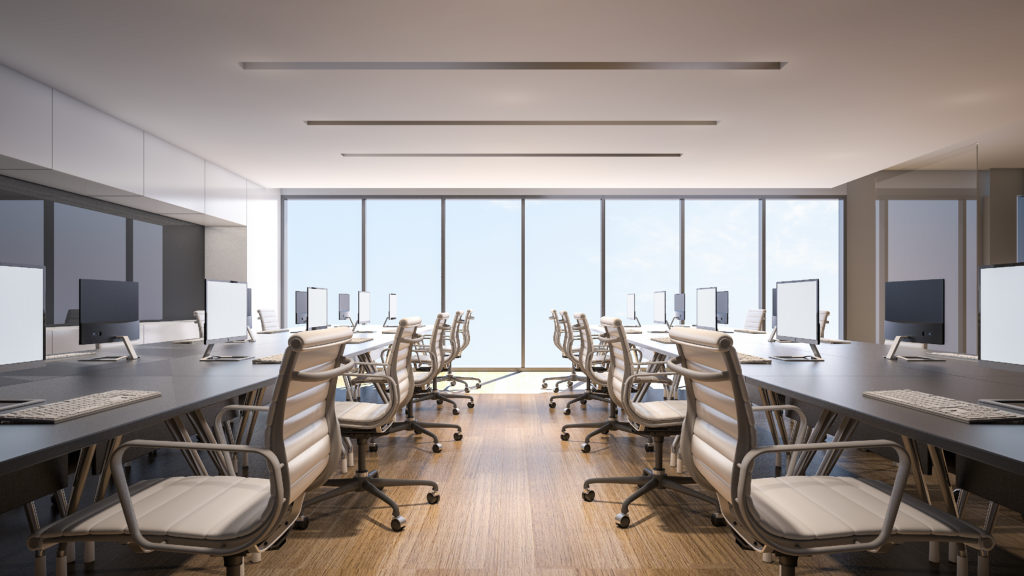
In the last year, Harvard Business School’s study determined that employees who moved from a traditional office setting to an open concept layout collaborated less with coworkers. In fact, the study showed that there was a reduction of face-to-face interaction by 70%, making designers and real estate decision makers reconsider the open-concept trend. The sensory overload that comes with an open office plan gets to a point where employees can’t function, and studies have debunked their benefits. So why are they extremely prevalent and why is it taking us so long to get rid of them?
Silicon Valley firms were among the first to tear down walls, eliminate private offices and develop successful open workspaces. However, the concept doesn’t work for every corporation and in general every individual. Sitting shoulder to shoulder with a lack of personal space has affected many employees to innovate and function in a collaborative and creative environment. Employees still require their personal space.
Dysfunctional office spaces trigger employee stress levels and promote depression and anxiety. Many employees seclude themselves from others with plugged earbuds to tune out office noise and conversations that occur amongst coworkers. Not to forget how open concept has developed the feeling of having a constant audience over your shoulders, increasing pressure to look extremely busy at all times. How about those excessive water drinkers and the fear they hold knowing that their coworkers are most likely tallying the amount of bathroom breaks they take? The anxiety they must have walking to and from the bathroom as well as the misery people have sitting next to someone who is sick and coughing into the same air bubble as yours.
Another study done by Queensland University of Technology showed that 90% of employees working in open-concept office spaces took more sick days than those stationed in single-person offices. With the increase of stress and high blood pressure, it should come as no surprise that job turnover increases.
WeWork is always looking at ways to mix private, open and event spaces all under one roof. The company develops layouts that are spoiled with sofas, café counters and a cool hip, tension-free vibe. The cutting-edge plans have only shaken other developers and owners to up their game in the industry. Every company is also looking for top talent, but in order to even have employees consider the job, they must evaluate what the company offers. With the increased use of mobile technology, employees want to switch up their environment and have the capability of working indoors, outdoors and at home.
Companies need to create physical workspaces that provide employees an exceptional experience. Open-concept offices replaced the traditional style and yet both seem to have negative affects on employees. We must analyze what works and what doesn’t and develop a biophilic design that creates active and smart workspaces. Biophilic designs bring nature to the office with natural lighting, materials and vegetation. Picture workspaces with numerous indoor plants, wooden furniture throughout and big windows engulfing the layout. Corporations such as AirBnb, Etsy, Amazon’s Sphere and Microsoft are good examples of businesses who follow the biophilic design.
Studies also have shown that illumination of natural sunlight in office spaces have 51% fewer cases of eyestrain and 63% fewer cases of headaches than fluorescent lighting. Working among natural elements has increased the well-being and creativity of employees by 15%, making them 6% more productive. Plants also improves on air quality and mood of employees, decreasing the amount of sick days that workers take.
Research also seems to suggest that open-concept offices are not the engines of collaboration that they are often made out to be. Some debate that having an open-concept environment eliminates the privacy necessary for slacking and chitchatting. Others debate that open concept layouts won’t prevent Chatty Cathy from stopping over to update you on office drama. Open concept offices also don’t allow employees to view expense reports, budget cuts, financial documents, emails, timesheets, contracts and more in privacy. In fact, it puts pressure on employees to check emails after hours and work overtime when no one is around.
Corporations are big fans of the open concept environment financially because it saves them dollar value per square footage. According to CoreNet Global, the average space allotted to individual employees fell from 225 square feet to 176 square feet. This saved businesses hundreds of millions of dollars in savings per year in some of the country’s largest companies. Innovative companies utilize more space throughout the office and don’t expect the desk to be the center of an employee’s work life. However, when it comes to office layouts, design and space are crucial and must be well-thought out. You don’t want employees to sacrifice their space, but instead have more power over their environment. They want a space they can call their own, no matter how big or small it is.
Employees are the reason your business is surviving and it’s important for them to feel comfortable in the space they can allow their creative juices to flow. If employers want to make the open-office model work, they must take into consideration improving the work efficiency. Another solution is to join the trend and allow employees to work from home. In the end, corporations must provide a healthy work/life balance in order to succeed.

